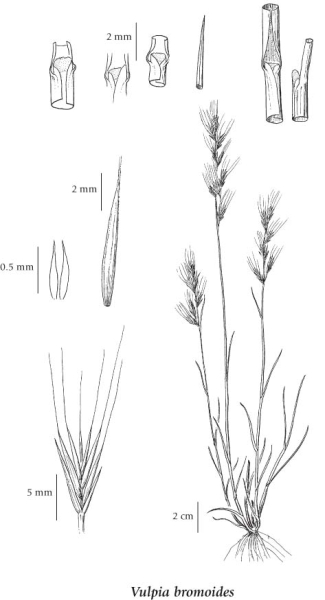Vulpia bromoides (L.) Gray
barren fescue (brome fescue)
Poaceae (Grass family)
Introduction to Vascular Plants
barren fescue (brome fescue)
Poaceae (Grass family)
Introduction to Vascular Plants
Species Information
General:
Annual, loosely tufted grass from fibrous roots; stems sometimes solitary, erect (sometimes bent or angled at the lower nodes), 5-30 (55) cm tall.
Leaves:
Sheaths smooth or short-hairy; blades usually in-rolled (sometimes flat), smooth or short-hairy, up to 1.5 mm wide; ligules 0.2-0.6 mm long.
Flowers:
Inflorescence an erect panicle, 2-8 (15) cm long, contracted when mature, the lower branches (and spikelet stalks) erect or appressed; spikelets 5-10 mm long (excluding the awns), (3-) 4- to 6- (8-) flowered, the florets loosely overlapping; glumes smooth, the lower glumes 1-nerved, 3.5-5 (7) mm long, the upper glumes 3-nerved, 4.5-7 (8) mm long; lemmas smooth or short-hairy, lanceolate, 5.5-7.5 (8) mm long, the terminal awns (3) 5-12 (15) mm long; rachilla internodes about 1 mm long; anthers usually 1 (rarely 2 or 3), 0.3-0.5 (2) mm long.
Illustration

If more than one illustration is available for a species (e.g., separate illustrations were provided for two subspecies) then links to the separate images will be provided below. Note that individual subspecies or varietal illustrations are not always available.
Illustration Source: The Illustrated Flora of British Columbia
Ecology
Ecological Framework for Vulpia bromoides
The table below shows the species-specific information calculated from
original data (BEC database) provided by the BC Ministry of Forests and Range.
(Updated August, 2013)
The table below shows the species-specific information calculated from
original data (BEC database) provided by the BC Ministry of Forests and Range.
(Updated August, 2013)
| Site Information |
Value / Class |
||
|
Avg |
Min |
Max |
|
| Elevation
(metres) |
180 | 1 | 869 |
| Slope
Gradient (%) |
34 | 0 | 105 |
|
Aspect (degrees) |
176 | 23 | 360 |
| Soil
Moisture Regime (SMR) [0 - very xeric; 4 - mesic; 8 - hydric] |
1 | 0 | 6 |
| Modal
Nutrient Regime
Class |
C | ||
| #
of field plots species was recorded in: |
92 | ||
| Modal
BEC Zone Class |
CDF | ||
|
All BEC Zones (# of stations/zone) species was recorded in |
BG(10), CDF(37), CWH(3), PP(1) | ||
|
Source:
Klinkenberg 2013
|
|||
Habitat and Range
Mesic to dry outcrops, bluffs, open forests, roadsides and disturbed areas in the lowland zone; common in SW BC, rare in SC BC; introduced from Europe, W Asia and N Africa.Status Information
Synonyms
Synonyms and Alternate Names:
Bromus dertonensis All.
Festuca bromoides L.
Festuca dertonensis (All.) Asch. & Graebn.
Vulpia dertonensis (All.) Gola